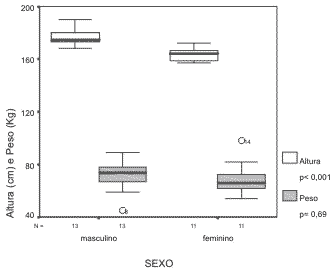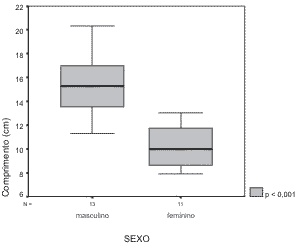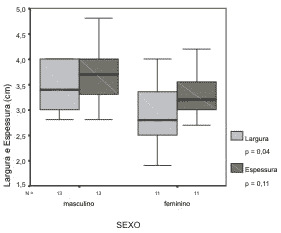

Year: 2003 Vol. 69 Ed. 3 - (13º)
Artigo Original
Pages: 371 to 374
Correlation between height and vocal folds dimensions
Author(s):
João Aragão Ximenes Filho[1],
Erich Christiano Madruga de Melo[2],
Christiano de Giacomo Carneiro[2],
Domingos Hiroshi Tsuji[3],
Luiz Ubirajara Sennes[4]
Keywords: body height, larynx, vocal cords, anatomy, histology.
Abstract:
Introduction: In some clinical situations or during laryngoplastic procedures, it is important the knowledge of the dimensions of the vocal folds. Objectives: The aim of this study was to evaluate the correlation existence among the individuals' characteristics studied as height, weight, age and sex with the macroscopic dimensions of the membranous portion of the vocal folds. Study Design: Experimental. Methods: We studied 24 cadavers (13 men and 11 women) submitted to autopsy from April and October of 2001. Of each individual, we obtained height, weight and age with subsequent removal of the larynx. We used digital pachimetry for the measures of the dimensions of the vocal folds. Results: We did not find difference between the vocal folds right and left in length (p = 0,91), width (p = 0,93) or thickness (p = 0,72). The masculine vocal folds were larger (p <0,001) and wider (p = 0,04) that the feminine ones, and it did not have difference between the thickness (p = 0,11). We observed a strong correlation (r=0,76) between the individuals' height and the length of the vocal folds. We did not find correlation between height and width (r=0,36) or thickness (r=0,39) of the vocal folds. Conclusions: Males vocal folds were larger and wider than females'. The length of the membranous portion of the vocal folds varied in function of the individuals' height.
![]()
INTRODUCTION
In the past decades, the number of procedures involving the laryngeal framework has increased. Surgeries to medialize the paralyzed vocal fold such as type I thyroplasty of Isshiki 1, to change fundamental frequency, such as types III and IV thyroplasties, techniques to correct glottic insufficiency 2, 3 and to advance anterior commissure 3, 4 have only become possible as a result of the advanced knowledge of laryngeal anatomy, histology and physiology.
Anatomically and physiologically, larynges of male and female subjects have different characteristics, which affects their vibration pattern 2. It is known that the angle between the laminae of the thyroid cartilage is larger in women and that the vocal folds are longer in men 2. However, there is limited knowledge about the individual variations in size of vocal folds among subjects of the same gender.
Thus, the purpose of the present study was to assess the existence of the correlation between characteristics of the studied subjects, such as height, weight and age and macroscopic dimensions of the membranous portion of the vocal folds. Special attention was given to the comparison between male and female larynx in order to observe possible differences.
MATERIAL AND METHOD
Sample
This research study was approved by the Ethics Committee for Research Studies Analysis (CAPPesq), Hospital das Clínicas, Medical School, University of São Paulo in April 2001, allowing its conduction and the procurement of pieces from the Service of Death Checking of the capital city of São Paulo (SVOC), with University of São Paulo.
We studied 24 cadavers being 13 male and 11 female pieces, between April and October 2001. Ages ranged from 29 to 90 years, mean age of 62.2 years and standard deviation of 17.4. As to race, 10 were Caucasian, 13 were African Brazilian, and 1 was Asian. They all lived in the city of São Paulo and were victims of non-violent death of causes not related to the larynx. We excluded those that had previously been submitted to tracheotomy, laryngeal surgery or radiotherapy on the cervical-facial region.
Method
Collection of larynx
After selection of the cadavers, we conducted an incision on the skin of the upper thoracic region and opened a cutaneous thoracic-cervical flap. The larynx was removed in bloc after section over the hyoid bone at the level of the 4th tracheal ring. In the laboratory, we conducted the laryngeal dissection.
Morphometric study
In the absence of macroscopic abnormalities using magnifying glass, we conducted macroscopic measures as reported below, dividing the parameters in two groups:
1. Characteristics of the subjects - in which we checked gender, age, height and weight of cadavers. To obtain the height, we used a metric tape, whereas weight information relied on the notes made on the medical chart of the cadaver by the SVOC and informed by family members;
2. Macroscopic characteristics of the vocal folds - in which we measured length, width and thickness of the membranous portion of the vocal folds, in millimeters, and half way between the anterior commissure and the vocal process of the arytenoid cartilage.
The macroscopic measures of the dimensions of the membranous portions of the vocal folds were conducted using the same examiner in order to prevent bias. Measures were conducted with the same pachymeter and following the sequence below: length and width, later conducing posterior opening of the larynx to the thickness measurement (superior-inferior dimension of the vocal folds). The length was measured from the attachment of the vocal folds on the thyroid cartilage, inferiorly to the petiole of the epiglottis up to its insertion to the vocal process of the arytenoid cartilage. The width was defined as the distance between the free margin and the transition between the vocal ligament and the floor of the laryngeal ventricle. The thickness was measured after the longitudinal incision of the cricoid cartilage, between the arytenoid cartilages, with minimum opening possible to allow opening of the pachymeter, and it expresses the cranial-caudal dimension of the vocal folds. It was defined as the distance between two parallel plans designed superiorly and inferiorly to the thyroarytenoid muscle.
Analyses conducted
The analyses were divides as follows:
1. Characteristics of the subjects, comparing the means obtained in the male and female groups;
2. Comparison between the macroscopic measures on the right and left sides of the vocal folds;
3. Correlation between gender and macroscopic characteristics of the vocal folds;
4. Correlation between the characteristics of the subjects and vocal fold dimensions.
Statistical analysis
We conducted Kolmogorov-Smirnov test to analyze the distribution of the collected data. Since we had a Gauss distribution, we employed parametric tests such as T student's test to compare gender and means. We investigated the existence of the correlation between the subjects' characteristics and the respective dimensions of the vocal folds using Pearson's correlation Coefficient. We considered significance level of 95% (p<0.05). The statistical program used was SPSS version 10.0 for Windows.
RESULTS
Characteristics of the subjects
The age of the male group was 58.7 ± 18.7 years, whereas in the female group it was 66.4 ± 15.6 years. Comparing both groups, there were no statistically significant difference (p=0.29). The mean height was 170.2 ± 8.9 cm, being 176.5 ± 6.1 cm in males and 162.6 ± 4.7 cm in females (p<0.001). The male group was on average 13.9 ± 2.25 cm taller than the female group. The mean weight was 70.5 ± 11.7 kg, being 71.5 ± 11.8 kg in males and 69.5 ± 12.1 kg in females (p=0.69). Graph 1 shows the comparison between such variables in both groups.
Comparison between the right and left sides
The comparative analysis between both sides did not show statistically significant differences concerning length (p=0.91), width (p=0.93) or thickness (p=0.72). It did not show statistically significant differences when we analyzed the right and left sides in the male and female groups. Thus, for each subject in the study, we had means for both sides in the studied variables length, width and thickness and we conducted the study next based on these means.
Macroscopic characteristics of the vocal folds concerning gender
As to length of vocal folds, we noticed that there was statistically significant difference (p<0.001) between the male and female groups. Upon analyzing the width of the vocal folds, we also had statistically significant differences between the male and female groups (p=0.04). In the analysis of thickness, there was no difference between the groups (p=0.11). In Graph 2, we can see the comparison of length, whereas Graph 3 shows the correlations of width and thickness and gender.
Correlation between the characteristics of the subjects and vocal fold dimensions
In Table 1 we can see the results showing a strong correlation (Pearson's coefficient greater than 0.75) between height of subjects and length of vocal folds. We did not find any correlation between width and thickness of vocal folds.Graph 1. Comparison between height and weight by gender.Graph 2. Comparison between length of vocal folds and genderGraph 3. Comparison between width and thickness of vocal folds and gender.Table 1. Pearson's correlation coefficient (r) and statistical significance (p).*Significant correlation at the level of 0.01.
DISCUSSION
Studies in human cadavers, since the detailed descriptions by Andreas Vesalius in the first half of the 14th century, have helped us better understand the human body. For laryngology in special, the anatomical studies in cadaver larynges have contributed to the understanding of the function of this important organ. The larynx starts its development on the third week of intrauterine life, as part of the prolongation of the pharynx, of endodermic origin. In the third intrauterine month it already presents the characteristics that are found upon birth 5. After birth, there are a number of modifications in geometrical configurations of the vocal tract. The length of the membranous portion of the vocal folds almost doubles in the first year of life, reaching, in adult life, 11.5 to 16 mm in men and 8 to 11.5 mm in women. The cartilaginous portion has mild growth, reaching 5.5 to 7 mm in men and 4.5 to 5.5 mm in women 6. There is progressive increase in the length of the intramembranous part of the vocal folds in the first two decades of life, with differentiation of genders at the age of 15 7.
A question that has also motivated the conduction of this study concerned shortening of the membranous portion of the vocal folds as a result of aging, especially in male subjects 8. In our study, however, we did not find correlation between age and length of the membranous portion of the vocal folds. The reason is probably because there are different forms of statistically analyzing it. In addition, we believe that vocal abnormalities resultant from aging are more related to microarchitectural changes of the vocal folds 9, 10 than modification in the macroscopic dimensions of the vocal folds.
In order to have as precise data as possible, we used a metric tape placed close to the body of the studied subject that was placed on his/her back to check height. However, for the measure of weight we used the medical chart of the subject, which was based on information collected from family members, since the weight of the subject could have been modified by the conditions that took them to death, such as edema, cachexia, dehydration, or still tissue modifications that occurred after death. Since height does not vary in such situations, this measure was more reliable.
In the statistical analysis of our results, we decided to apply the statistical tests of Pearson's correlation. This test does not translate results of cause-effect relation, but shows whether there is correlation between the independent variable (height, age, gender and weight) and the different variables studied (dimensions of the vocal folds).
The main findings in this preliminary study confirmed the hypothesis that there is a correlation between subjects' height and length of vocal folds and the observation that men and women of the same height, do not have vocal folds of the same length, showing that the differences in laryngeal framework reflect differences in the membranous glottis.
CONCLUSIONS
We concluded that there was a correlation between height and length of vocal folds and there was no correlation of height and width and thickness of vocal folds. We did not find correlation of vocal folds and weight or age of subjects We observed statistically significant differences between the vocal folds of men and women concerning length and width, which was not observed for thickness.
REFERENCES
1. Isshiki N, Tsuji DH, Sennes LU. Tireoplastias. 1a ed. São Paulo, SP: Bios Comunicação e Editora; 1999.
2. Slavit DH. Phonosurgery in the elderly: a review. Ear Nose Throat J 1999;78:505-9, 12.
3. Tucker HM. Laryngeal framework surgery in the management of the aged larynx. Ann Otol Rhinol Laryngol 1988;97:534-6.
4. LeJune FE, Guice CE, Samuels, PM. Early experiences with vocal ligament tightening. Ann Otol Rhinol Laryngol 1983;92:475-7.
5. Behlau M. Voz - O Livro do Especialista. Rio de Janeiro, RJ: Revinter; 2001.
6. Aroson AE. Clinical Voice Disorders. 3rd ed. New York, NY: BC Decker, 1990.
7. Kurita S, Nagata K, Hirano M. A comparative study of the layer structure of the vocal fold. In Bless D, Abbs J, eds. Vocal fold physiology contemporary research and clinical issues. San Diego, California: College-Hill; 1983.
8. Hirano M, Kurita S, Sakaguchi S. Ageing of the vibratory of human vocal folds. Acta Otolaryngol 1989;107:428-33.
9. Sato K, Hirano M. Age-related changes of elastic fibers in the superficial layer of the lamina propria of vocal folds. Ann Otol Rhinol Laryngol 1997;106:44-8.
10. Hammond TH, Gray SD, Butler J, Zhou R, Hammond E. Age- and gender-related elastin distribution changes in human vocal folds. Otolaryngol Head Neck Surg 1998;119:314-22.
1 - Ph.D. in Otorhinolaryngology, Medical School, University of São Paulo (FMUSP). Assistant Physician (volunteer), Service of Otorhinolaryngology, University Hospital, Medical School, Federal University of Ceará.
2 - Doctorate studies under course, Discipline of Otorhinolaryngology, FMUSP.
3 - Full Professor, Responsible for the Group of Voice, Division of Clinical Otorhinolaryngology, Hospital das Clínicas, FMUSP.
4 - Full Professor, Associate Professor, Discipline of Otorhinolaryngology, FMUSP; Director of the Service of Bucopharyngolaryngology, Hospital das Clínicas, FMUSP.
Address correspondence to: João Aragão Ximenes Filho - R. Paula Ney, 700 60140-200 Fortaleza CE - Tel (55 85) 268-3641 - E-mail: joaoximenesf@bol.com.br
Study conducted at the Discipline of Otorhinolaryngology, Medical School, University of São Paulo (FMUSP) and presented at 36o Congresso Brasileiro de Otorrinolaringologia, Florianópolis-SC, November 2002.



